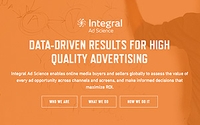Media Quality Is Important (But What Does Quality Mean?)
- by Felicia Greiff , December 17, 2015
 An Integral
Ad Science (IAS) survey of 400 digital advertising professionals found that everyone agrees media quality is important -- but not everyone has the same definition of quality.
An Integral
Ad Science (IAS) survey of 400 digital advertising professionals found that everyone agrees media quality is important -- but not everyone has the same definition of quality.
The study indicated a clear split over the viewability/quality issue, with agencies/brands on one side and DSPs, publishers and networks on the other.
Last month, Integral Ad Science released a report, which found that despite the industry’s frequent discussions about non-viewable ads, viewability didn’t improve in Q3. The company's end-of-year survey on industry attitudes also focused on viewability — specifically, how digital ad professionals differ in their opinion of what makes a quality, viewable media unit.
Here are some of the key findings, with comments from David Hahn, SVP-product management, Integral Ad Science.
- The majority of respondents said media quality is important.
- Seventy-five percent of respondents from brands and 72% from agencies agree that a non-viewable ad has zero value. The majority of publishers, DSPs and networks didn’t agree. “In my mind I don’t see how an ad with 0% viewability has any value to anybody. So, it might be a difference in how you define a non-viewable ad versus a viewable ad,” said Hahn, adding that if an ad is potentially seen for half a second, it could have some value.
- Most respondents from DSPs (70%), publishers (71%) and networks (69%) agreed that the MRC Standard for viewability is strict enough. Only 17% of brand respondents and 30% of agency respondents concurred. Hahn said people are having a knee-jerk reaction on the buy and sell side, and there’s a little tension between the two parties in terms of what is acceptable. “Publishers are trying to figure out what it means to their revenue, but also how to manage it all,” Hahn said.
- Forty-three percent of respondents said they believe viewability discrepancies are the biggest barrier to transacting on viewability, a topic Hahn said will continue to be central in 2016.
“We’re looking at what optimum amount of time and frequency is needed to expose somebody to an ad for them to react and purchase from your brand,” Hahn said. There’s work to do, he added, but there’s a lot of interest in this direction.
Earlier this month, Integral Ad Science announced a new program showcasing media sellers who use the company’s “discrepancy-free” viewability measurement.


